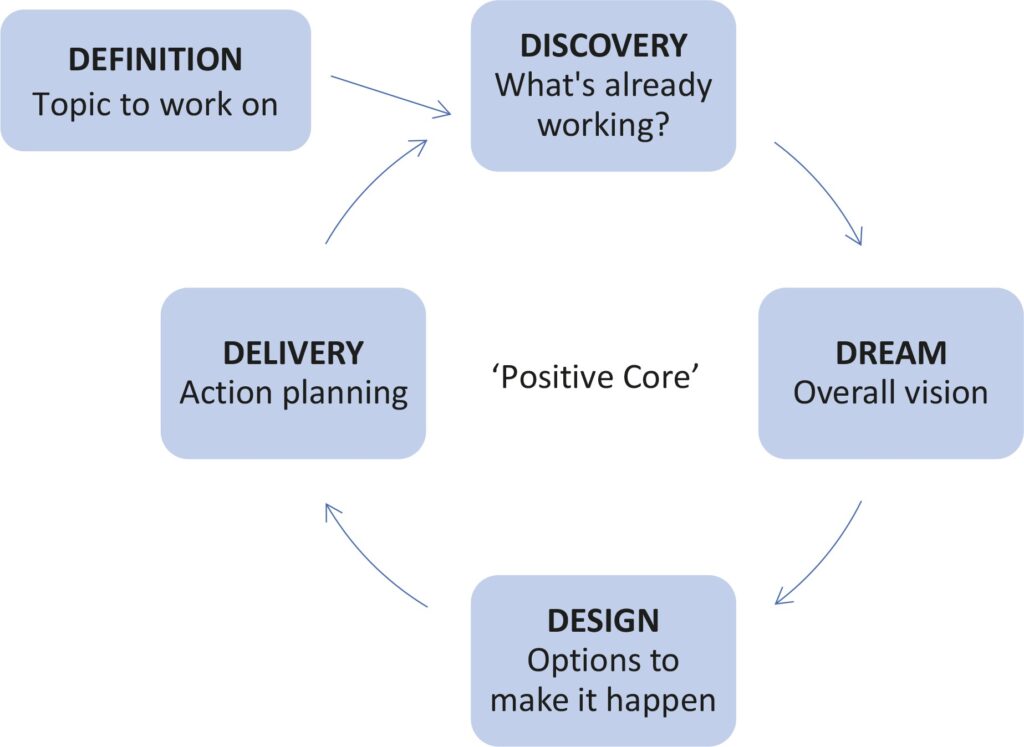
Learning to use Appreciative Inquiry
By Rachel Arnold. Originally published on the Integration and Implementation Insights blog.
What is Appreciative Inquiry? How does one shift from research that focuses on problems and negative details to the strengths-based approach of Appreciative Inquiry? What are the benefits and requirements of such an approach? And what is it about Appreciative Inquiry that fosters change?
Appreciative Inquiry, developed by David Cooperrider and Suresh Srivastva, is a five-step process (originally four steps), as shown in the figure below. The steps are:
- Definition – deciding what to study is critical in moving humans in a positive direction
- Discovery – discovering and appreciating best experiences
- Dream – imagining the ideal – how it would be if those valued experiences happened most of the time
- Design – defining the dream more clearly and discussing steps towards realizing it
- Destiny – implementing wide ranging actions, improvisation, learning, and adjustments.
Appreciative Inquiry is a collaborative and energizing process that enables people to connect emotionally with their situation, consider others’ perspectives and change how they see their situation. It has the potential for transformational change as people start to see compelling images of what could be – and are inspired to act. It has been used in business, the armed services, health settings and social work.

The change process in Appreciative Inquiry is underpinned by five main theoretical principles:
- Simultaneity principle
This claims that change begins the moment we ask a question. Questions have the potential to turn people’s attention in a different direction enabling them to see things from an alternative perspective.
- Anticipatory principle
The images or mental pictures that we have of the future inspire us into actions that can make them happen. One of the strengths of Appreciative Inquiry is that it is possibility-centric rather than problem-centric. Rather than fixing a problem, Appreciative Inquiry highlights the strengths of communities and helps them to discover possibilities.
- The constructionist principle
The language and words we use not only describe reality but have the power to shape it. Therefore, the stories that are told during Appreciative Inquiry are key, because they become part of the narrative, identity, and culture.
- The poetic principle
We can choose what we study or focus on, and whatever we focus on will grow. In Appreciative Inquiry, the telling and retelling of stories about the things that are valued, meaningful, and represent the ‘best of’, are considered a powerful catalyst for change.
- The positive principle
Positive questions shift people’s attention from problems to what gives life, what excites, energizes and nourishes them. In addition, positive emotions enhance resilience, openness to new ideas and creative thinking, and help build relationships and more cohesive communities.
Reflections on conducting Appreciative Inquiry
- The skills of the Appreciative Inquiry facilitator
Appreciative Inquiry is much more than asking different questions or using an unfamiliar ‘method;’ it required a change in my thinking and perspective. The facilitator/researcher really needs to think about how to frame questions, probe and reflect. When a participant talks about difficulties, the inclination is to delve into the negative details. An Appreciative Inquiry facilitator, however, needs a new internal paradigm that enables one to explore the issue from a different angle and instigate conversations about how participants would like things to be ideally. In addition, I learnt to notice and affirm the skills, courage, determination and resilience of participants. Conversations with other Appreciative Inquiry practitioners were an essential part of my personal journey, for practical suggestions and also for reinforcing and deepening this different way of seeing, speaking and being.
- Interviewing using the Appreciative Inquiry approach
Appreciative Inquiry interviews can be time consuming and produce a lot of data. The aim is not to obtain ‘facts’ about events and experiences, but it is a relational process to generate stories that are told in such detail by the participants that they connect with the emotions of the event, uncover new understandings and create purpose. It requires a safe, unhurried space and often takes careful probing, listening and reflecting. It is important to consider potential lengths of interviews when designing study protocols and deciding on participant numbers.
- The role of negative experiences
One major criticism of Appreciative Inquiry is that it does not attend to negative experiences and problems like the power dynamics and abuses that can be part of complex organisations. Important issues could therefore be repressed, allowing leaders and managers to avert focus away from challenges. Appreciative Inquiry is about authentic relationships and meaning, however, which can include the ‘shadow side.’ When participants were distressed I listened without trying to manage, reframe or control until all was said – and then focussed on strengths and new possibilities. This did not appear to undermine the process, but rather enabled a deeper engagement between the researcher and interviewee.
- Support by senior management
In an organisational setting the support of senior managers is vital in being receptive to staff wanting to initiate changes. Transformation is also more likely if there is a good fit between the aspirations of the group and the ideals of the organisation.
- Appreciative Inquiry can be used in pressured circumstances
My experience using Appreciative Inquiry during the worst of the COVID pandemic highlighted that it can be an excellent tool in times of turmoil because it is a time when people are dealing with change, rethinking approaches and priorities in their work and private life. This may be a good time to ask questions and provide space for reflection.
Conclusion
My experience is based on a study of staff wellbeing in a UK maternity service during the COVID-19 pandemic. Do you have other reflections or lessons to share about using Appreciative Inquiry?
To find out more:
This i2Insights contribution is based (sometimes verbatim) on the following paper, which also provides the relevant references:
Arnold, R., Gordon, C., van Teijlingen, E., Way, S. and Mahato, P. (2022). Why use Appreciative Inquiry? Lessons learned during COVID-19 in a UK maternity service. European Journal of Midwifery, 6 (May): 28. (Online – open access) (DOI): https://doi.org/10.18332/ejm/147444
Reference:
Smith, A. (2022). What is Appreciative Inquiry? Coaching Leaders website. (Online): https://coachingleaders.co.uk/what-is-appreciative-inquiry/
Biography:
 |
Rachel Arnold PhD, Centre for Midwifery and Women’s Health at Bournemouth University, UK, is also a former nurse and midwife. Her research focuses on the challenge of achieving sustainable improvements to the quality of care, and also the complex institutional, social, personal and political factors that influence behaviours and care. |
Article source: Learning to use Appreciative Inquiry. Republished by permission.
Header image source: Adapted from Clker-Free-Vector-Images on Pixabay.






